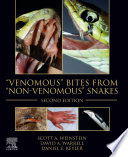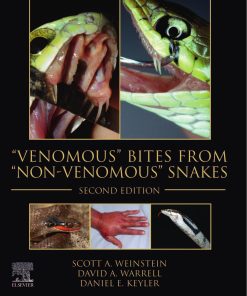Venomous Bites from Non Venomous Snakes 1st edition by Scott Weinstein 0128227877 9780128227879
$50.00 Original price was: $50.00.$25.00Current price is: $25.00.
Venomous Bites from “Non-Venomous” Snakes 1st edition by Scott A Weinstein – Ebook PDF Instant Download/DeliveryISBN: 0128227877, 9780128227879
Full download Venomous Bites from “Non-Venomous” Snakes 1st edition after payment.

Product details:
ISBN-10 : 0128227877
ISBN-13 : 9780128227879
Author : Scott A Weinstein
“Venomous” Bites from “Non-Venomous” Snakes, Second Edition thoroughly examines the potential hazards associated with bites by non-front-fanged snakes (popularly, but inaccurately, called “rear-fanged snakes”). This diverse group contains approximately 80% of living snake species (approximately 2,900 species). A large proportion of these snakes were previously assigned to the family Colubridae but, as a consequence of expanding systematics investigations, have been split into multiple families and subfamilies. Many of these snakes produce venoms or oral secretions that contain toxins and other biologically active substances. A large variety of non–front-fanged snakes figure in the pet industry, yet little documented information or formal study of their potential medical importance has been published. Therefore, although the possible medical importance of many of these species has been subjected to speculation since the mid-19th century, there is a limited amount of useful descriptive information regarding the real hazard (or lack thereof) of this wide variety of snakes.
Venomous Bites from “Non-Venomous” Snakes 1st Table of contents:
Chapter 1. A summary of taxing taxonomic considerations: non-front-fanged snakes and the shifting sands of systematics
1.1. The shifting sands of taxonomic reassignments and their relevance to the envenomed patient
1.2. Brief glimpses of a vast landscape: the basics of taxonomic reassignments and discordance of morphological and molecular systematics investigations
1.3. Outlined inventory of a recent higher phylogeny of Caenophidian snakes
1.4. General phylogenetic inventory of Caenophidian snakes: comments and consideration of known medical significance
Chapter 2. Differences between buccal gland secretion and associated venom delivery systems of front-fanged snakes and non-front-fanged snakes: Low- versus high-pressure gland function and canaliculated versus solid dentition
2.1. Basic considerations regarding gland structure and function
2.2. Overview of hypotheses for the evolution of venom-delivery systems and other adaptive gland functions
2.3. Theories considering the evolution of canaliculated fangs and enlarged grooved teeth
2.4. Low-pressure ‘Duvernoy’s glands’ and high-pressure venom glands: a question of semantics?
Chapter 3. A brief overview of the history of non-front-fanged snake venom research
3.1. Background and beginnings
3.2. The modern era: advances and attributions
3.3. A brief overview of major classes of non-front-fanged colubroid venom components (see Tables 3.2–3.4)
Chapter 4. Medically significant bites by non-front-fanged snakes (NFFCs)
4.1. Typical features of documented cases and evidence-based risk
4.2. Some representative genera: typical features of bites and an overview of their natural history and toxinology
Colubridae, Ahaetuliinae
4.3. Life-threatening and fatal cases: non-front-fanged snakes with lethal potential and assessment of evidence-based risk
4.4. Aberrant cases and representative cases without clear etiology: a critical assessment of risk
4.5. Pitfalls noted in documented cases: Differentiating Perceived versus Evidence-Based Risk
4.6. Recommendations for management of medically significant non-front-fanged snake bites
Chapter 5. Summary and conclusions
People also search for Venomous Bites from “Non-Venomous” Snakes 1st:
animals with venomous bites
insects with venomous bites
do humans have venomous bites
how to treat venomous bites
most venomous bites
Tags: Venomous Bites, Non Venomous, Snakes, Scott Weinstein
You may also like…
Reference - School Guides & Test Preparation
Biography & Autobiography
Education Studies & Teaching - Education Management & Organisation
Biology and other natural sciences
Romance
Sugar Plum: Haret Chronicles Qilin: A Fantasy Romance (Sugar Bites Book 7) Laurel 9798438395041












